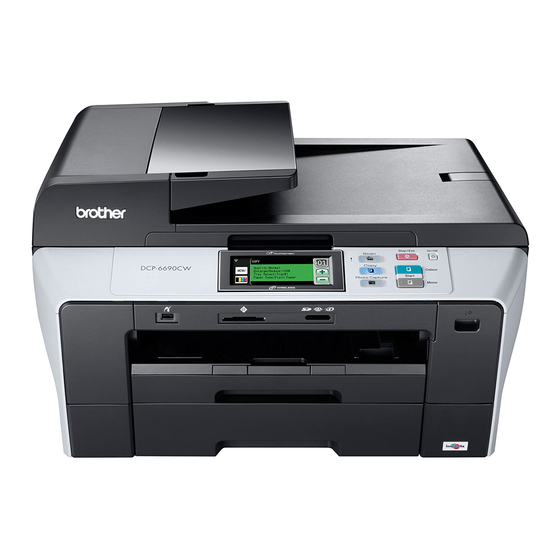
User Manuals: Brother DCP-6690CW Inkjet Printer
Manuals and User Guides for Brother DCP-6690CW Inkjet Printer. We have 4 Brother DCP-6690CW Inkjet Printer manuals available for free PDF download: Service Manual, Network User's Manual, User Manual, Quick Setup Manual
Brother DCP-6690CW Service Manual (507 pages)
Brand: Brother
|
Category: All in One Printer
|
Size: 41 MB
Table of Contents
-
-
Front View16
-
Outline16
-
Back View17
-
-
Dcp6690Cw18
-
Mfc6490Cw20
-
Mfc6890Cdw23
-
LCD Screen25
-
-
Components27
-
-
-
-
Overview55
-
1 ] Overview65
-
2 ] Features66
-
-
1 ] Overview79
-
-
Components109
-
-
Error Indication113
-
Equipment Errors113
-
-
-
Calling143
-
DCN Reception146
-
ID Checking146
-
Signal Isolation147
-
Equipment Error148
-
Maintenance Mode148
-
-
Introduction149
-
Precautions149
-
9 ] Others160
-
Paper Jams161
-
8 ] Speaker169
-
10 ] Pcbs170
-
At the User Site174
-
End Page Sample176
-
-
-
Preparation184
-
-
Assembling Notes192
-
-
ADF Rear Cover197
-
Lower ADF Chute201
-
Main PCB226
-
Assy231
-
-
CR Encoder Strip240
-
Head Cover241
-
-
-
Speaker Harness279
-
Lubrication287
-
Requirements295
-
-
Preparation295
-
-
Cleaning337
-
-
-
Function Code351
-
-
Test Pattern356
-
-
Reading Labels414
-
Wsw01433
-
Wsw02435
-
Wsw03436
-
Wsw04437
-
Wsw05438
-
Wsw06440
-
Wsw07442
-
Wsw08443
-
Wsw09444
-
Wsw10445
-
Wsw11446
-
Wsw12447
-
Wsw13448
-
Wsw14449
-
Wsw15450
-
Wsw16451
-
Wsw17452
-
Wsw18453
-
Wsw19454
-
Wsw20455
-
Wsw21456
-
Wsw22457
-
Wsw23458
-
Wsw24459
-
Wsw25460
-
Wsw26461
-
Wsw27462
-
Wsw28463
-
Wsw29464
-
Wsw30465
-
Wsw31466
-
Wsw32467
-
Wsw33468
-
Wsw34469
-
Wsw35470
-
Wsw36471
-
Wsw37472
-
Wsw38473
-
Wsw39474
-
Wsw40475
-
Modem Attenuator476
-
Wsw41476
-
Wsw42477
-
Wsw43477
-
Wsw44478
-
Wsw45479
-
Wsw46480
-
Wsw47481
-
Wsw48482
-
Wsw49482
-
Wsw50483
-
Wsw51484
-
Wsw52485
-
Wsw53486
-
Wsw54487
-
Wsw55488
-
Wsw56488
-
Wsw57489
-
Wsw58490
-
Wsw59492
-
Wsw60493
-
Wiring Diagrams495
-
Circuit Diagrams498
-
Mj Pcb499
-
Backup Battery506
Advertisement
Brother DCP-6690CW Network User's Manual (175 pages)
Multi-Protocol On-Board Ethernet Multi-Function Print Server and Wireless (IEEE 802.11b/g) Ethernet Multi-function Print Server
Brand: Brother
|
Category: Print Server
|
Size: 5 MB
Table of Contents
-
-
-
Overview19
-
-
IP Address19
-
Subnet Mask20
-
-
-
-
-
Overview28
-
-
-
-
-
-
Network Menu87
-
Tcp/Ip87
-
BOOT Method87
-
Subnet Mask90
-
WINS Config94
-
WINS Server95
-
Dns Server96
-
-
Comm.mode104
-
-
Mail Address106
-
Setup Server107
-
Setup Relay115
-
-
-
Passive Mode117
-
Port Number117
-
-
-
-
-
Overview129
-
-
-
-
Setup Mail TX142
-
Setup Mail RX142
-
Error Mail142
-
-
-
Overview146
-
Brother DCP-6690CW User Manual (137 pages)
Copier printer
Brand: Brother
|
Category: All in One Printer
|
Size: 5 MB
Table of Contents
-
-
-
-
Sleep Mode34
-
LCD Screen35
-
-
How to Copy38
-
-
-
Print Images51
-
-
Cropping58
-
Date Print58
-
-
-
-
Cannot Print94
-
-
-
Menu Table104
-
-
Mode Keys104
-
Menu Table105
-
Network Menu106
-
Print Settings117
-
-
Entering Text119
-
-
Advertisement
Brother DCP-6690CW Quick Setup Manual (43 pages)
Brand: Brother
|
Category: All in One Printer
|
Size: 3 MB



